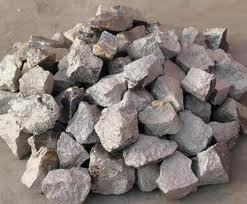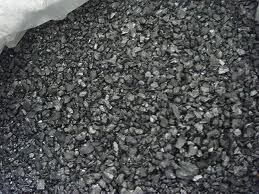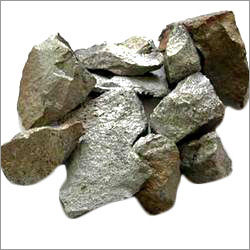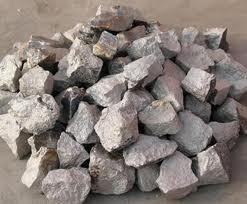Ferro Vanadium
Ferro Vanadium Specification
- Dimensions
- Varied as per requirement
- Impurity Content (%)
- Max 1.5%
- Product Type
- Ferro Alloy
- Shape
- Lump
- Size
- Lumps / Pieces
- Application
- Steel manufacturing, Hardening agent
- Color
- Grey
Ferro Vanadium Trade Information
- Minimum Order Quantity
- 50 Kilograms
- Supply Ability
- 50 Kilograms metric ton Per Month
- Delivery Time
- 1 Week
- Main Domestic Market
- All India
About Ferro Vanadium
Ferro VanadiumFerro Vanadium offered finds usage as popular alloy and as universal strengthener for all grades of steel and provides special suitability for high-strength structural steel as well as tool steel. It is also used as a main component in production of carbon steel used for infrastructure purposes and is also added to crude steel for creating product that is lightweight as well as bears high tensile strength & wear resistance.
Specifications :
| Grade | Vanadium | Aluminum | Silicon | Carbon | Phosphorus | Sulfur |
| Regular | 77-82% | 1.5% max. | 1.5% max. | 0.25% max. | 0.08% max. | 0.08% max. |
| Low-Aluminum | 76-82% | 0.50% max. | 1.5% max. | 0.25% max. | 0.08% max. | 0.08% max. |
Other Specifications :
| Product | Specification | Size | Packing | Origin |
| Ferro Vanadium | V: 50% min C: 0.40% max Si: 2% max Al: 1.5% max P: 0.1% max S: 0.04%max Mn: 0.50% max | 10-50mm (90% min) | 100 Kgs Steel Drum | China |
Superior Alloying Power for Steel
Ferro Vanadium enhances the structural properties of steel, making it tougher and more resistant to wear and corrosion. Its high vanadium content and low impurities ensure optimal hardening and grain refinement in steel manufacturing, contributing to robust industrial solutions.
Consistent Quality and Global Standards
Produced to meet ASTM and ISO standards, our Ferro Vanadium ensures reliable performance and consistency. Manufactured in India, every batch undergoes stringent quality checks, making it a trusted choice for exporters, importers, and steelmakers across the globe.
Flexible Packing and Customization
Available in lump or piece form, our Ferro Vanadium is packed according to client needs, using jumbo bags or drums. We offer varied dimensions to cater to diverse operational requirements, guaranteeing convenience in handling, storage, and transportation.
FAQs of Ferro Vanadium:
Q: How is Ferro Vanadium used in steel manufacturing?
A: Ferro Vanadium is added during steel production as a hardening agent and grain refiner. It enhances the tensile strength, toughness, and corrosion resistance of the finished steel, making it ideal for critical applications in construction, tools, and automotive components.Q: What is the process of producing Ferro Vanadium with 78% vanadium content?
A: The production involves smelting a blend of vanadium-bearing materials and iron at high temperatures (about 1700C) using advanced metallurgical techniques. This process is carefully controlled to meet strict standards on vanadium content and impurity levels, ensuring a consistent and high-quality alloy.Q: When should Ferro Vanadium be added during steelmaking?
A: Ferro Vanadium is typically introduced to the steel melt during the final stages of alloying, once the base steel has been refined. This ensures uniform distribution of vanadium throughout the steel matrix, resulting in improved mechanical properties.Q: Where is your Ferro Vanadium manufactured and exported from?
A: Our Ferro Vanadium is manufactured in India, following ASTM and ISO standards. It is exported and supplied to clients globally, including markets in China and other industrial regions seeking superior alloying agents for steel production.Q: What are the benefits of using high-purity Ferro Vanadium?
A: High-purity Ferro Vanadium guarantees minimal levels of sulphur, phosphorus, and other impurities, which prevents undesirable reactions during steelmaking. The result is higher strength, better workability, and improved lifespan of steel products.Q: What packing options are available for Ferro Vanadium shipments?
A: We offer Ferro Vanadium in both jumbo bags and drums, ensuring safe and convenient transportation. Our packing solutions are designed to accommodate varied order sizes and handling requirements, maintaining product integrity during transit.Q: How does low impurity content in Ferro Vanadium impact its effectiveness?
A: A low impurity content (max 1.5%) enhances the alloys performance in steelmaking by reducing the risk of defects and ensuring consistent mechanical properties. This leads to superior end-products and greater efficiency in the manufacturing process.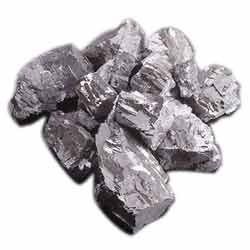

Price:
- 50
- 100
- 200
- 250
- 500
- 1000+
More Products in Ferro Alloys Category
Medium Carbon Ferro Manganese
Minimum Order Quantity : 50 Kilograms
Application : Other, Steel production, foundries, deoxidizer, alloying element
Product Type : Other, Medium Carbon Ferro Manganese
Shape : Other, Lumps, Granules
Weight : Bulk, packed as per requirement (typically 50 kg, 1 MT bags)
Carbon Additive (C)
Minimum Order Quantity : 50 Kilograms
Application : Other, Steelmaking, Foundry, Cast iron production
Product Type : Other, Carbon Additive (C)
Shape : Other, Granular / Powder
Weight : 25 kg bag / As required
Color : Black

 Send Inquiry
Send Inquiry Send Inquiry
Send Inquiry
